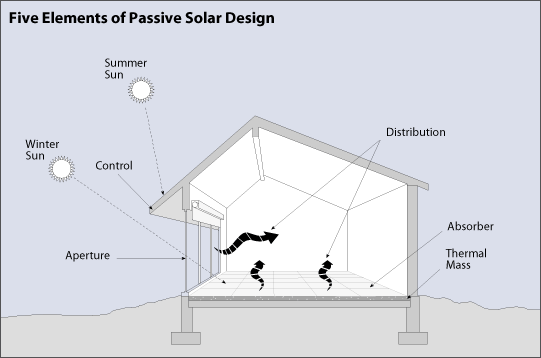Passive Solar Building Design
by Nick Gromicko, CMI®
Passive solar building design is a strategy by which a building’s windows, walls and floors can be designed to collect, store and distribute solar energy in the form of  heat in the winter, and vent solar heat in the summer. Passive solar techniques are applied most easily to new construction, but existing buildings can be retrofitted to passively take advantage of the local climate. A successful passive heating system will incorporate the following five principles in its design:
heat in the winter, and vent solar heat in the summer. Passive solar techniques are applied most easily to new construction, but existing buildings can be retrofitted to passively take advantage of the local climate. A successful passive heating system will incorporate the following five principles in its design:
 heat in the winter, and vent solar heat in the summer. Passive solar techniques are applied most easily to new construction, but existing buildings can be retrofitted to passively take advantage of the local climate. A successful passive heating system will incorporate the following five principles in its design:
heat in the winter, and vent solar heat in the summer. Passive solar techniques are applied most easily to new construction, but existing buildings can be retrofitted to passively take advantage of the local climate. A successful passive heating system will incorporate the following five principles in its design:- aperture, or the glazing through which sunlight enters the building. These windows should face within 30º of true south and receive light unobstructed by shade during hours of peak solar intensity;
- absorber, or the surface of the heat-storage element that sits in the direct path of incoming sunlight. Common surfaces used for this purpose are dark-colored floors and masonry walls;
- thermal mass, or the material that retains the heat converted from sunlight. The thermal mass is thus the material beneath or behind the absorber;
- distribution, or the method by which heat circulates throughout the building from its point of collection. Ducts, fans and blowers may be implemented to assist with distribution, although such a system would not be purely passive; and
- control. Some means of control will prevent overheating during summer months, or whenever the passive heating system need not operate unimpeded. Electronic sensing devices, operable vents and dampers, awnings, low-emissivity blinds, and roof overhangs are all common means of passive solar-heating system control.
Successful passive solar design systems apply the aforementioned principles in one or more of the following techniques:
- Direct gain is the simplest passive solar home design technique. Sunlight enters the house through windows without interference, and the heat collection, storage and distribution all occur within the same space. When light reaches floors and walls, they absorb and store the solar heat. At night, the stored heat energy warms the room through convection and radiation. A few tips:
- Water-filled containers are sometimes installed by builders or homeowners to absorb and store solar heat. While this measure may increase the efficiency of a direct-gain system – water stores twice as much heat as masonry per unit of volume – water requires carefully designed structural support and periodic inspection for microbial growth.
- The thermal mass must be insulated from its colder exterior. Collected solar heat will drain away rapidly if the thermal mass is not insulated, especially if it’s connected to the ground, or if the outdoor temperature is lower than that desired for the mass.
- To use it to its best advantage, keep windows clean, and install window treatments that enhance passive solar heating, reduce night-time heat loss, and prevent summer overheating. Dirty windows can significantly impede direct-gain energy yields.
- Indirect-gain passive solar is a technique by which thermal energy is stored in an area adjacent to (but not part of) the living space. A thermal mass, such as a water tank or Trombe wall, absorbs the sun’s heat energy through glazing, and slowly releases it through convection and conduction. Compared with direct gain, indirect gain experiences a time lag and potential heat losses at night. Also, the costs of insulated glazing, and developing a system to distribute heat throughout the living area can be excessive.
- Isolated gain involves utilizing solar energy to passively move heat from or to the living space using a fluid, such as water or air, by natural convection or forced convection. The most common example of isolated-gain passive-solar home design is a sunspace, also known as a solar room or solarium. Simple and reliable sunspaces have vertical windows with no overhead glazing. Temperature fluctuations, caused by an over-abundance of glazing, can be moderated through the incorporation of thermal masses, such as masonry floors, masonry walls or water containers. Also, the sunspace is typically separated with doors or windows from the rest of the building so that it isn’t overly affected by temperature fluctuations. To prevent unwanted solar gain during the summer, overhangs, earth cooling tubes, and other passive cooling techniques can be integrated into the system. In addition to the sunroom, the following heating techniques incorporate isolated solar gain:
- thermosiphon, in which natural convection circulates heated liquid without the help of a mechanical pump;
- a Barra system, named for Italian solar designer Horazio Barra, in which a collector wall captures solar radiation and uses the thermosiphon effect to transfer warmed air through channels in reinforced concrete floors; and
- the double-envelope house, which is essentially a house within a house, in which natural convection pumps solar heat through the cavity between the envelopes.
In summary, passive solar building design techniques in either old or new construction use simple, inexpensive ways to heat and cool a building.

